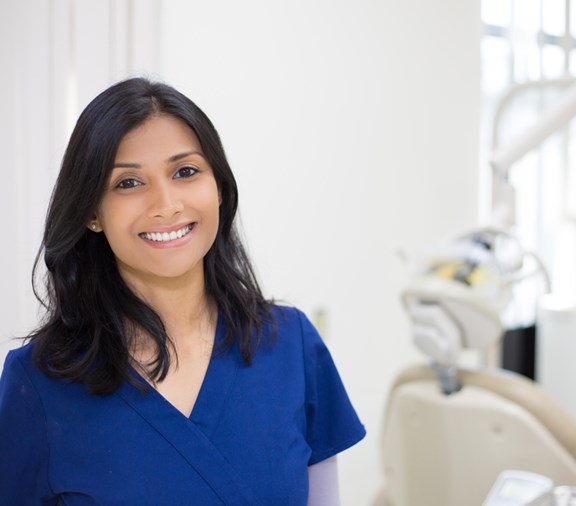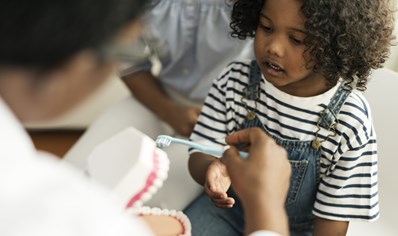
Healthy teeth are an important part of your overall health. After all, none of us want to feel discomfort or pain when biting, chewing, brushing, flossing—and smiling!
The best way to keep your teeth and gums as healthy as possible is to visit your dentist for routine checkups and cleanings. Ask your dentist if you should come once a year or more often.
Reasons to schedule a dentist appointment
Even if you do not notice any symptoms, you might have a tiny cavity in a tooth or plaque or tartar beneath your gumline, where your toothbrush cannot reach. The dentist can find problems when they are small and easy to treat.
If you do notice pain or other symptoms, call your dentist ASAP. The sooner you get it checked, the faster you can get help.
According to the American Dental Association, you should schedule an appointment if:
- You are pregnant
- You have diabetes or an eating disorder
- You smoke
- You chew tobacco
- Your teeth are sensitive to hot or cold foods or drinks
- Your gums are puffy
- Your gums bleed
- Your mouth is dry a lot
- You have bad breath even after brushing
- Your mouth, face, or neck is swollen or painful
- It’s hard to chew or swallow
- You have family members with dental problems
What to do if you are nervous about the dentist
It’s normal to feel a little nervous about going to the dentist. The good news is that people who work at dental offices are very understanding. They know that fear of the dentist is common, especially for people who have not had a cleaning for a long time.
When you call to make your appointment, be sure to mention if you have fears or questions about what to expect. Remind the dental team when you arrive for your visit. They will do everything they can to help you relax and be comfortable.
Another good tip: Schedule your appointment for the time of day that works best for you. For some people, that means first thing in the morning. Others like to go later in the day.
Leave plenty of time for filling out any forms, especially if you are seeing the dentist for the first time. Remember to bring your insurance information.
What happens during a dental visit?
Some dental offices have a large team, and several different employees might see you for different parts of your exam. Other offices are smaller, so one or two employees will work with the dentist to perform the checkup, cleaning, and anything else you may need.
A visit might include a medical history, X-rays, a cleaning and, finally, an exam by the dentist.
Medical history
At the start of your appointment, you will be asked about your medical history. This could include recent pregnancies, surgeries, allergies, dental symptoms, and any health conditions, such as diabetes.
X-rays
Your dentist might want to see X-rays of your mouth, including your teeth and facial bones. Getting X-rays at the dentist is fast and easy. You might even be able to stay in your chair.
Dental cleaning
Before the dentist examines your mouth, a dental hygienist—and sometimes an assistant—will give your teeth and gums a thorough cleaning.
First, they will cover your chest with a cloth and give you some mouthwash to “swish and spit.” Before starting the cleaning, the dental hygienist will look closely at your teeth and gums using a small mirror and a bright light.
Then, the hygienist will use one or more tools to clean any build-up of plaque and tartar. They will clean along your gum line and between and behind your teeth. Their tools might feel like metal picks scraping your teeth; other tools may shoot a thin spray of water.
Once the plaque and tartar are removed, the hygienist will brush and floss your teeth. After your rinse, the hygienist might offer a fluoride treatment for extra protection.
You will be able to rinse out your mouth—and take breaks—several times during your cleaning.
Exam by the dentist
After your cleaning, the dentist will do a thorough exam. They will check every tooth carefully, using a thin probe to find any gaps or pockets between your teeth and gums. If the dentist finds any problem areas, they’ll let you know if you need any further treatment.
If you have questions before, during or after your dental appointment, be sure to ask. The most important member of the dental team is—you!
Get Extra Benefits and Paid Rewards for Dental and Vision Care
HEALTHfirst (STAR Medicaid) members age 21 and older can get up to $300 per year for dental services, including checkups, x-rays, and cleanings.
HEALTHfirst and KIDSfirst (CHIP) members can get $100 every 2 years toward new frames.
Learn more about extra benefits and paid rewards here.



